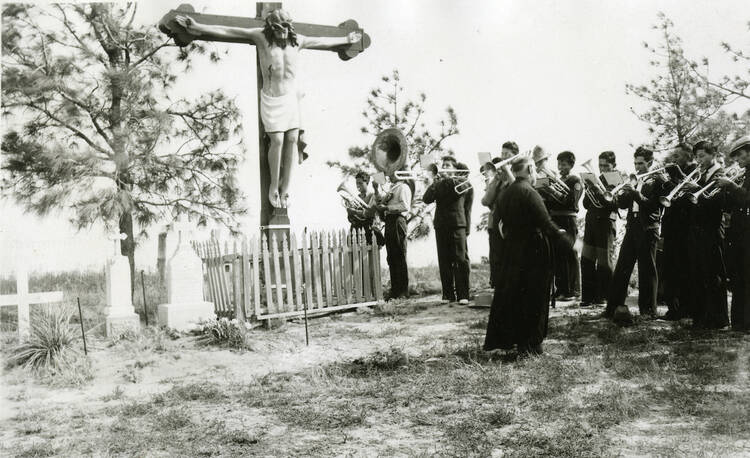When Holy Rosary Mission was founded on the Pine Ridge Indian Reservation in South Dakota in 1888, many of the Jesuits and Franciscan sisters who established the mission learned the Lakota language. The missionaries believed this method of inculturation would be pastorally effective.
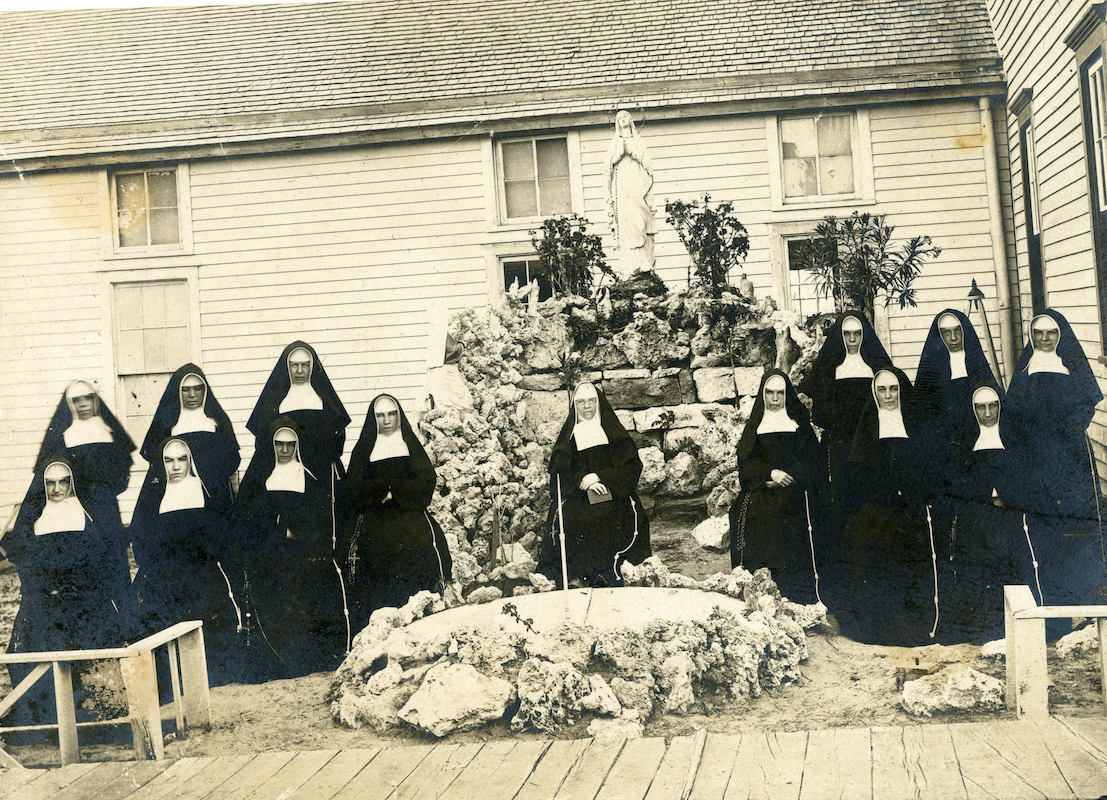
Ironically, in the boarding school they founded at Holy Rosary Mission, they prohibited native Lakota speakers from speaking their own language, following the policy of the federal government at the time. In so doing, the men and women religious became complicit in the destruction of the Lakota culture.
We—a Lakota Catholic Red Cloud alumnus and a white Jesuit in formation—are working directly on the Red Cloud Indian School Truth and Healing initiative to address this history.
A traumatic history
The founding of Holy Rosary Mission was part of a much larger project of colonization ultimately engineered by the United States government. More than 300 boarding schools were funded by the government and often run by various Christian denominations. Like the boarding school at Holy Rosary Mission (renamed Red Cloud Indian School in 1969), these schools were places where aspects of Indigenous culture were unwelcome and prohibited. The government’s vision for the boarding schools was explained by one of their architects, General Richard Henry Pratt of the Carlisle Indian Industrial School in Pennsylvania, as a method of assimilation: “Kill the Indian, save the man.”
To ensure the efficacy of this assimilation, the boarding schools relied on removing children from their families. While the church today preaches the sanctity of family life and the need for values and faith to be passed down in the family, in the 19th and 20th centuries in North America, the church participated in the process that systematically broke apart Native families.
One survivor from Holy Rosary Mission described the family separation as “detrimental” to the bond between parents and their children. “That’s probably the most important thing they took away from us…. You lose that part of your culture…. I think you go around the rest of your life not knowing who you are.”
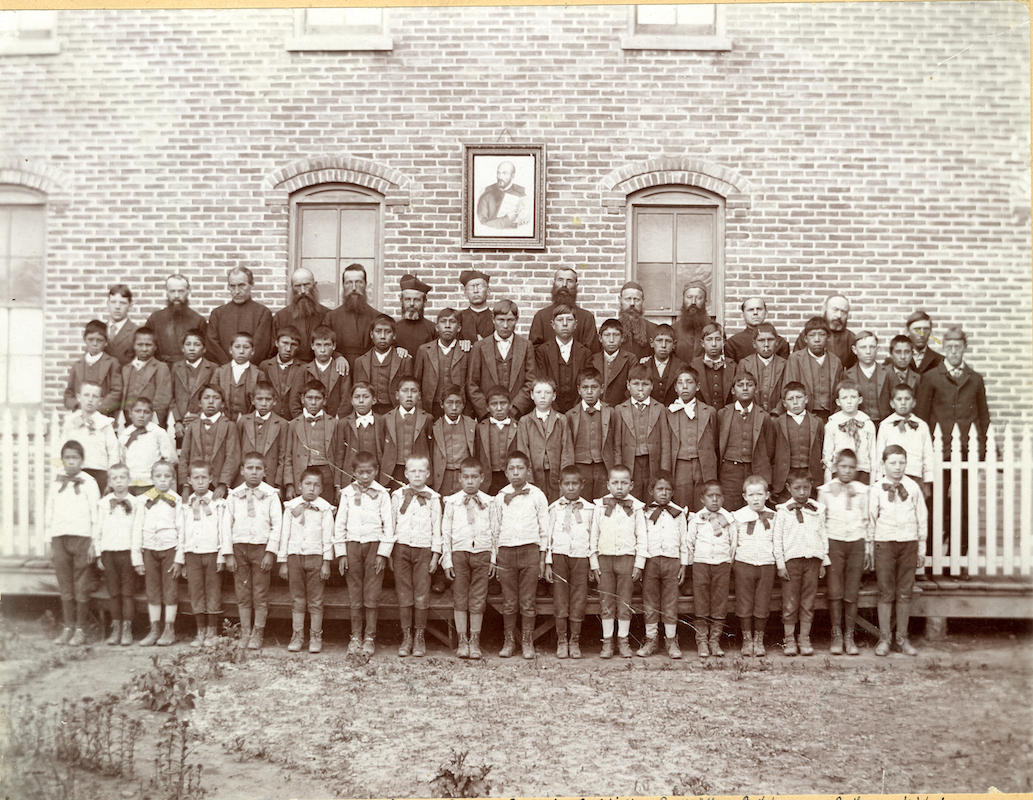
Long hair was cut, given names were changed and traditional dress was banned at most of these schools, including Holy Rosary Mission. “I found it very ironic,” said a survivor of the mission about having his hair cut. “[They] told me one thing, and then they showed us Christ on the cross who had long hair.”
“We regret our participation in the separation of families and the suppression of Native languages, cultures and sacred ways of life,” said the Jesuit Conference of Canada and the United States in a statement last month. “While these practices and our participation in such schools ended decades ago, their traumatic effects have continued to reverberate through the generations and are still very present with many today.”
“Fundamental to these schools were structures and practices which forced Indigenous children to be separated from their families and prohibited these children from speaking their language and practicing their culture.”
“We regret our participation in the separation of families and the suppression of Native languages, cultures and sacred ways of life,” said the Jesuit Conference of Canada and the United States.
Indigenous Peoples' Day and Orange Shirt Day
Many Native peoples recognize the history of Indigenous cultures on two days every Fall. In addition to Indigenous Peoples’ Day, which is celebrated this year on Oct. 11 in the United States, many throughout Canada and the United States are beginning to commemorate the historical traumas suffered by Native peoples as a result of colonization every Sept. 30, on what has come to be known as Orange Shirt Day. Orange Shirt Day is named for Phyllis Webstad, a survivor of St. Joseph’s Residential School in Williams Lake, British Columbia, who remembers wearing an orange blouse her grandmother had purchased for her on her first day of school.
“When I got to the Mission, they stripped me and took away my clothes—including the orange shirt!” recalled Ms. Webstad of the Stswecem’c Xgat’tem First Nation. “I never wore it again,” she added. “The color orange has always reminded me of that and how my feelings didn’t matter, how no one cared, and how I felt like I was worth nothing.”
In addition to Indigenous Peoples’ Day on Oct. 11, many throughout Canada and the United States are beginning to commemorate Orange Shirt Day every Sept. 30.
The tensions we experience at Red Cloud today stem directly from its foundations as part of a similar colonial project. The Jesuits came to Pine Ridge at the invitation of Chief Red Cloud, but the deleterious impacts of their assimilative efforts, made in conjunction with the United States government, are undeniably still felt—part of the reason that Orange Shirt Day resonates among the Native people of Red Cloud today.
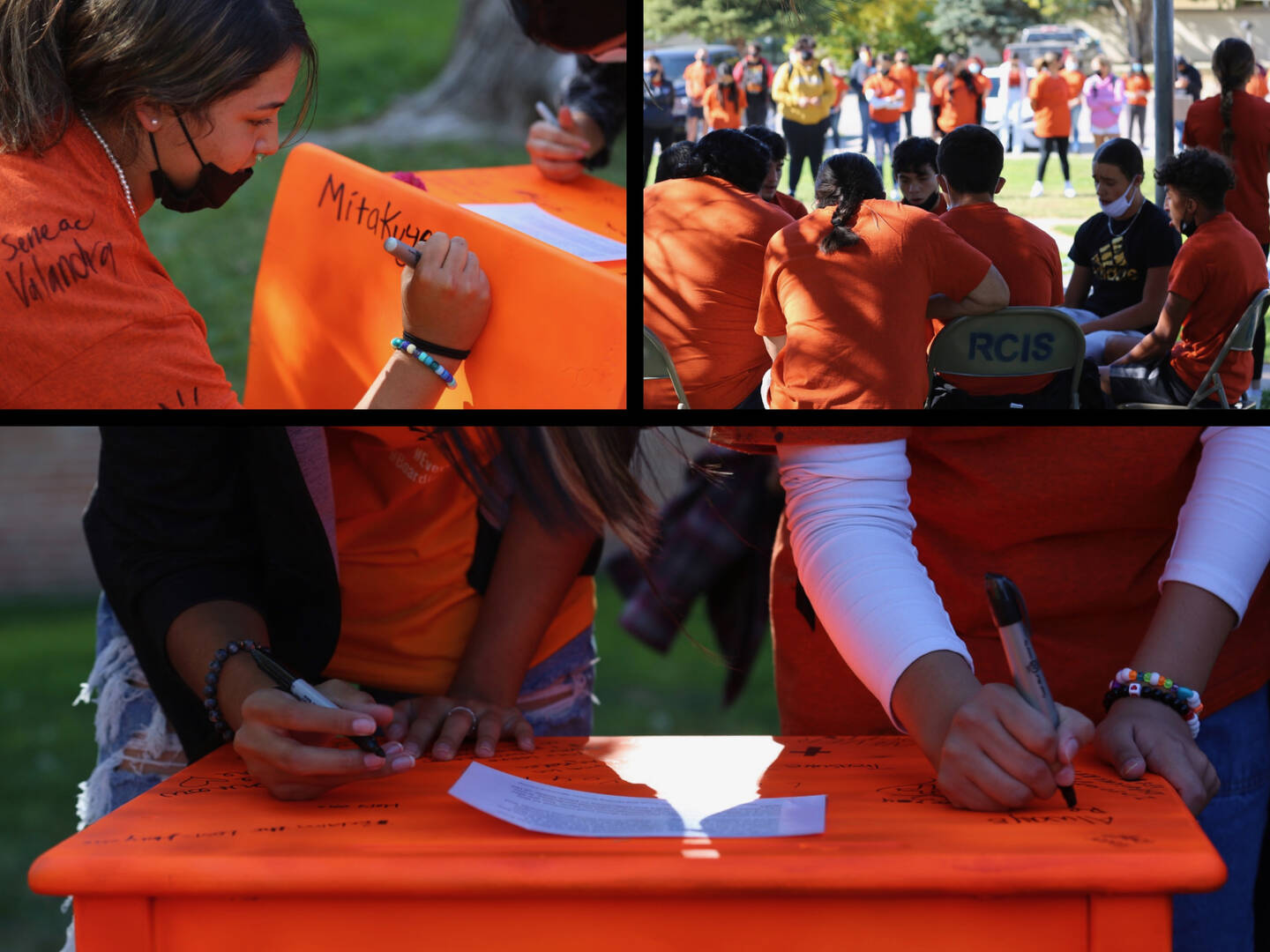
As part of Orange Shirt Day commemorations this year, students at Red Cloud created a memorial using early 19th century school desks they retrieved from our store. They painted the desks orange and invited the community to write on them, and also to offer memorials of flowers, fruits and traditional medicines as a way to honor the estimated 6,000 children who died in Native American boarding schools across North America.
From the very same desks students were once prohibited from speaking Lakota, our students wrote, in Lakota, words of remembrance and honor.
From the very same desks students were once prohibited from speaking Lakota, our students wrote, in Lakota, words of remembrance and honor.
The mission today
Formerly an institution that systematically suppressed the Lakota language, Red Cloud Indian School is a Lakota language immersion school today. Lakota culture and sacred rites are also practiced and taught in our classrooms, and Native artists and culture are supported through our Heritage Center.
Yet the changes that have taken place at Red Cloud over the years can appear hollow—because our tragic past has not been adequately acknowledged. That is why we have embarked upon a truth and healing process modeled on the research of Dr. Maria Yellow Horse Braveheart, a psychologist who has studied the effects of generational trauma and pathways to healing. Dr. Braveheart lays out a four-pronged path to addressing this trauma: confrontation, understanding, healing and transformation. It is our hope this process will help us to acknowledge this damage and move our community towards collective healing.
At Red Cloud, we are now in the confrontation stage. This includes collecting the stories of survivors and facilitating frequent talking circles among our community to provide space to unpack this history and its impact on our present. Some survivors carry with them stories of pain; others carry fond memories and gratitude for their time at Holy Rosary. Their stories will help create a full picture of our history.
Formerly an institution that systematically suppressed the Lakota language, Red Cloud Indian School is a Lakota language immersion school today.
Confrontation has also meant initiating a community-wide process that will culminate in the use of ground-penetrating radar (G.P.R.) on our campus. It is already clear to us that in our historic cemetery, there are graves that have lost their markers. This technology will help us determine the exact location of these graves and allow us to mark and memorialize them in a way that honors those buried there.
Confrontation has also spurred questions from students and educators for our classrooms and curriculum. What does it mean to teach American Literature, for example, in an English department at a former boarding school where English was once mandated as a way to assimilate children into white culture?
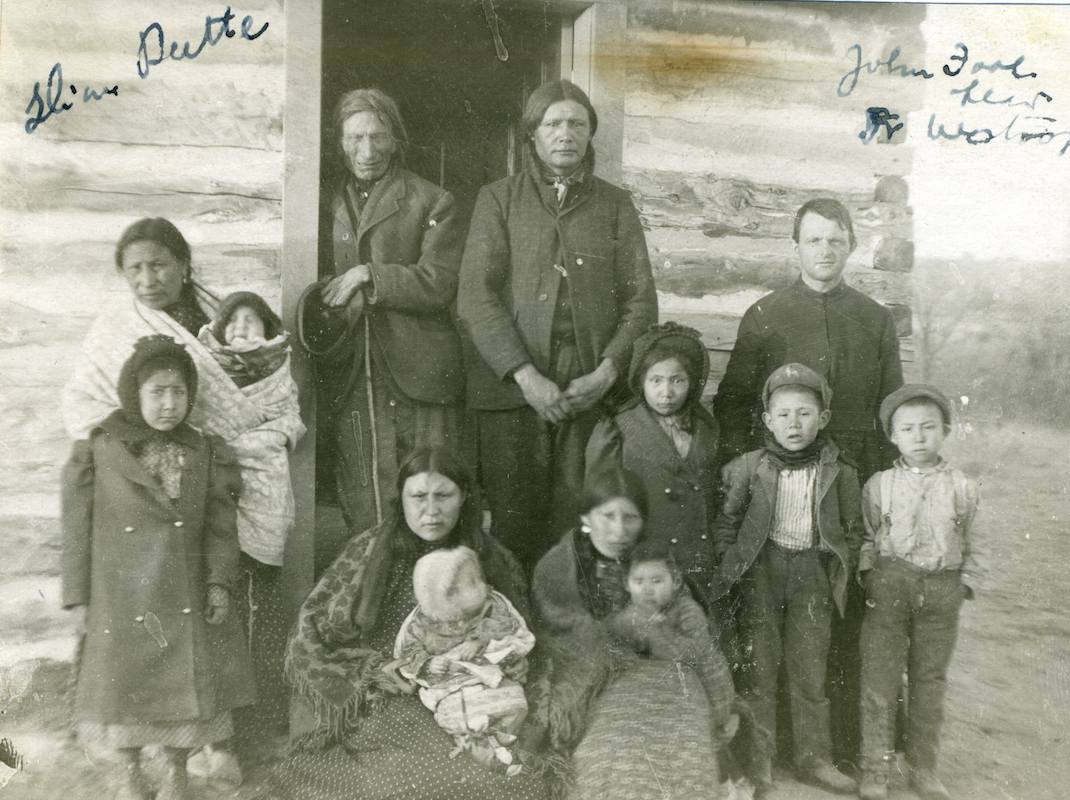
An exploration of our Lakota-Catholic identity is also fundamental to the experience of confrontation. We are fully aware that some members of the Lakota community wish that Red Cloud was no longer a Catholic school. Yet there are Lakota people who wish Red Cloud would claim an even more vibrant Catholic identity. We believe that an essential component of confronting this past is facing these questions directly and at their deepest levels. No amount of balancing Lakota and Catholic spiritual practices by equal weight or mandate can address the fundamental issue of discomfort or anger toward Catholicism.
Red Cloud Indian School is ground zero for the long-needed intercultural and interreligious dialogue that seeks to address the tragic history of the Native American boarding school system.
Red Cloud Indian School is ground zero, in many ways, for the long-needed intercultural and interreligious dialogue that seeks to address the tragic history of the Native American boarding school system. For Indigenous people, this is family history. We have grandparents who were in these boarding schools and can draw a straight line through trauma experienced across generations. For Jesuits, and other white Catholics, our spiritual lineage and privilege is directly tied to this history of colonization.
We are all wounded by this history. All people are affected by intergenerational trauma, and experience themselves as both oppressor and oppressed.
Delving into this history probes both the mysteries of evil and of grace. We do not know yet what it looks like to be a decolonized church. We hope, however, that by engaging the past and its legacy we can move toward collective healing and discover new pathways of relationship between Indigenous peoples and the Catholic Church.

